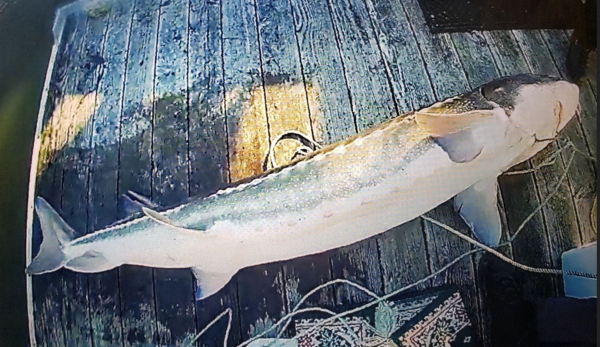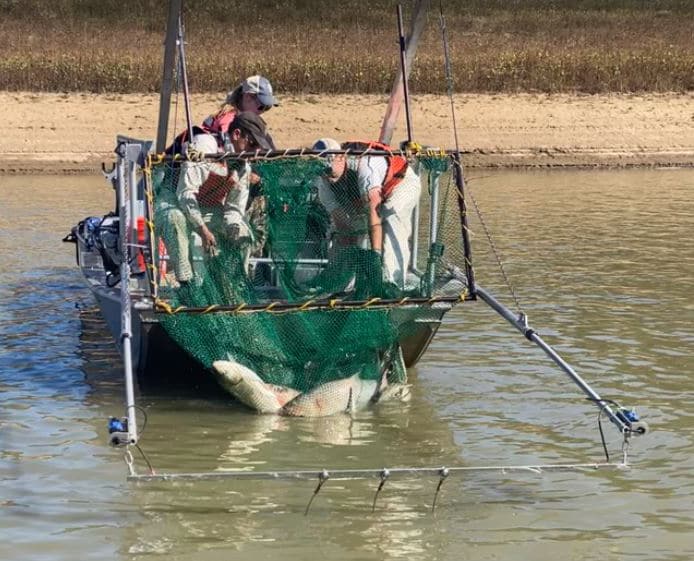
- If you want to do catch and release, remember From Hook To Release: How Gear Can Make A Difference For Fish Survival
- from The Fishing Wire
By Greyson Webb
Your odds of success on the water can hinge on the gear you use, and the same principle applies when it comes to releasing fish. From not meeting size requirements to being caught out of season, there are many reasons why you might land a fish that you’ll need to release.
While released fish can go on to survive and be caught again, there are a variety of stressors a fish can experience throughout their landing and handling that can result in injury or death. Simply letting a fish go does not guarantee its survival, and the use of proper gear is a best fishing practice that can be adopted to help minimize stressors and improve a fish’s chance of recovery and survival.
What makes certain tools more effective in minimizing stress and injury than others? This article explores how the tools used throughout the catch and release process can boost the survival rates of released fish to keep populations healthy for the environment and anglers alike.
Non-Offset, Non-Stainless Steel Circle Hooks
It all starts with the hook—the first point of contact between angler and fish. The right hook will minimize hooking injury, reduce stress, and improve the ease of hook removal—all factors that influence a fish’s chance of survival. This is where the circle hook can make a difference. Circle hooks are designed to catch a fish in the jaw, which is the safest area if release is needed. Less likely to be swallowed or snag vulnerable areas like the gills or eyes, circle hooks decrease the odds of a potentially fatal hooking.
Not all circle hooks are the same, though. Non-offset circle hooks and non-stainless steel circle hooks go the extra mile in improving a fish’s chance of survival after release. Non-offset hooks are easier to remove than offset hooks, meaning less time out of the water for the fish, less bleeding caused by removal and less stress overall. In the case a hook cannot be removed, a non-stainless steel circle hook provides the benefit of degrading and shedding up to three times faster than a hook made of stainless steel or other non-corrodible metals.
Pro tip: If you’re wondering whether a hook is stainless or non-stainless steel, “Tournament Approved” labeling usually indicates non-stainless steel. For a quick test, you can also use a magnet to check the material. Simply place a magnet on a hook: if it sticks, the hook is stainless steel; if it doesn’t, you’ve got yourself a non-stainless steel circle hook.
Knotless, Rubberized Landing Nets
While not necessary for landing every fish, landing nets are a functional tool that help shorten fight time, reduce stress on the line and rod, and prevent potential poking or piercing by hooks, teeth, or spines as you land your fish. However, landing nets with coarse mesh can inadvertently damage a fish’s delicate fins, scales, or protective slime layer—increasing their vulnerability to infections or injuries. Made from a smoother and friction-reducing material, knotless, rubberized landing nets help in preventing these potential traumas. With the protective slime layer preserved and more scales and fins intact, a fish landed with a knotless, rubberized net is a fish that has a better chance of survival after release.
If you prefer to use your hands to land a fish, using wet hands or rubber gloves provides similar relief to that of a knotless, rubberized landing net.
Dehooking Tools
The clock starts ticking the moment a fish is brought out of the water—its chances of survival dropping the longer it stays out of its natural environment. This is when a dehooking tool can help fish and anglers alike. Designed to rapidly remove hooks while causing minimal injury to the fish, time is not wasted struggling with a tough hook and the risk of injury during hook removal—for both the fish and the angler—is greatly reduced. It’s a win-win.
That said, there are situations where it is better to leave the hook in place. If a fish is deeply hooked in the gut or throat, attempting to remove the hook can often do more harm than good. In these cases, it is best to simply cut the leader close to the hook and leave it in the fish—particularly if it is a non-stainless steel hook, which has a greater chance of being shed. Research indicates this is less damaging and gives the fish the best chance for survival.
Descending Devices
If you land a fish and notice it has bulging eyes, bubbling scales, difficulty swimming below the surface, or organs protruding from the mouth or anus, it is likely suffering from barotrauma. Similar to the bends experienced by divers, barotrauma is an injury that can occur when a fish is brought from the high-pressure environment of deep waters to the low-pressure environment of the surface. This change in pressure can cause the gases in a fish’s swim bladder to expand, damaging organs and making it difficult for the fish to return to its original depth. Barotrauma is particularly common in deep-dwelling species, such as some snappers and groupers. Untreated, a fish experiencing barotrauma becomes vulnerable to predators, the elements, and the injuries of barotrauma itself. Fortunately, the right tool can help reverse this condition.
Descending devices are tools that use added weights to lower fish back to their depth of capture. As the fish is pulled down the water column by a descending device, the swim bladder recompresses, and the fish is given a better chance at survival. Descending devices all work to return a fish to their original depth, but they come in different forms: inverted hooks, weighted crates, and lip clamps.
An inverted hook is a barbless hook with an added weight that is inserted either through the original hook hole or through the soft tissue on the fish’s lower jaw. Rigged to a rod and reel, the inverted hook guides the fish back to its proper depth. Once there, a gentle tug on the rod will release the fish if it hasn’t already slid free.
Similar to an inverted hook, the lip clamp is a descending device that uses an attached weight to pull a fish back to depth by attaching to a fish’s lower jaw. However, instead of piercing the jaw, the clamp securely grips it. A lip clamp can be pressure triggered or spring triggered for release. A pressure triggered lip clamp includes a pressure-sensor mechanism designed to automatically release fish once the desired depth is reached. A spring triggered lip clamp requires you to manually open the lip clamp by pulling up on the rod once the fish reaches the desired depth.
A weighted crate, often referred to as a fish elevator, is a crate with an open top—such as a milk crate—that has a rope attached to the closed bottom along with weights. To use one, place the fish in the crate, quickly flip it upside down into the water, and let the attached weights sink the contraption. Acting as a bottomless cage, the weighted crate will bring fish back to depth, where they recompress and can swim away on their own.
A good rule of thumb when using any descending device is to use one pound of added weight for every five pounds of fish.
Given their benefits, many of these tools—such as descending devices, dehooking tools, and non-offset, non-stainless steel hooks—are required to be readily available or in use when fishing for or possessing snapper grouper species in federal waters off the coasts of North Carolina, South Carolina, Georgia and Eastern Florida. Interested in learning more about the practices and requirements that give snapper grouper species a better chance at survival after release in the South Atlantic? Check out the South Atlantic Fishery Management Council’s Best Fishing Practices campaign for more information and ways to get involved.













